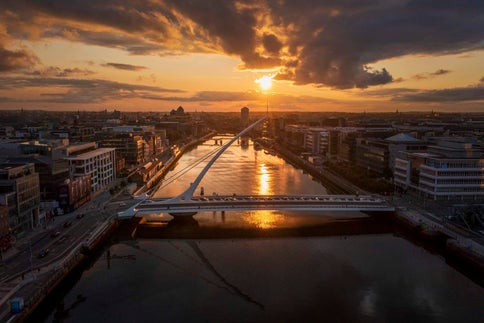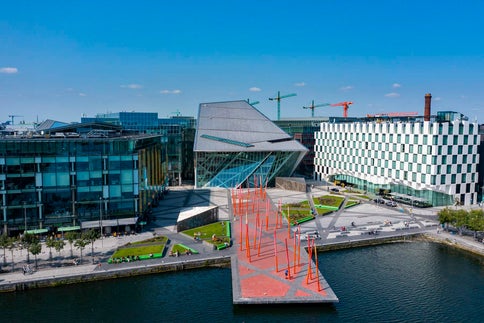- Home
- Traveller guides
- Take a South Wall stroll
Take a South Wall stroll

Take a walk along the South Wall and you’ll be met with great views of Dublin Bay.
When you’re in the middle of Dublin city, it can be easy to forget just how close you are to the coast. But in just 20 minutes you can be standing on the seawall where the River Liffey meets the ocean. At the tip of that wall is the Poolbeg Lighthouse, a bright red beacon that marks the entrance into the city.
This is the Great South Wall, and a walk along the length of these old stones is the perfect introduction to Dublin’s coastal landscape.
- 1.
- 2.
- 3.
- 4.
The Great South Wall
At nearly 5km long, the Great South Wall (originally known as The Piles) was the longest seawall in the world when it was completed in 1731. Though that title has since been taken by a seawall in South Korea, the Great South Wall remains one of the longest in Europe.
At the wall’s end sits the Poolbeg Lighthouse, one of the most distinctive landmarks in Dublin. The original lighthouse was built back in 1767 and was operated initially using candlelight, before converting to oil in 1786. The stocky, bright red lighthouse that we see today was redesigned and constructed back in 1820.

The walk
There are two walking routes along the Great South Wall. The shorter 3.4km route starts right at the wall itself and takes around 40 minutes, while the longer trail begins in Sandymount Strand and takes a couple of hours to complete.
However, both routes include the same walk along the length of the Great South Wall, straight out to the Poolbeg Lighthouse and back again. The old thick stones underfoot only add to the sense of character, though you’ll need to watch your footing as they can be uneven in places. On either side of the wall, giant black boulders protect the edges down into the bay, where seabirds plunge into the water and emerge with tiny fish in their beaks. Get lucky, and you might even see some seals or dolphins popping their heads up from the sea, as this is a core zone in the Dublin Bay Biosphere.
To the right of the South Wall, you can see a long stretch of the South Dublin coast, from Sandymount down to Killiney, with Dalkey Island and Muglins Lighthouse in the distance. Behind the shoreline are the Dublin Mountains, with the peaks of Wicklow further beyond, from the Great Sugar Loaf to its little sister mountain. Look to the left of the wall and you’ll get a clear view of Bull Island and Howth.

Time your walk right, and you’ll be overtaken by one of the numerous ferries that make their way in and out of Dublin Port each day. You’ll often spot a few waving passengers on the deck, as their ship manoeuvres between the red and green buoys and makes its way out to sea.
At the end of the wall, you’ll be met with a giant street art portrait of James Joyce, just before you reach the lighthouse itself. Take a walk around its base and you can see the difference in colour where it’s been repainted in patches, from an orangey red to a vibrant shade of hot pink. It’s at this final point where you can stand and look at the bay as it opens up before you, the horizon dotted with cargo ships and the odd sail boat.

If you fancy a longer stroll, the second route is a 10.2km trail that starts in Sandymount Strand and twists around the edge of the Irishtown Nature Park. The path leads you right to the start of the Great South Wall, where you complete the linear walk to the lighthouse before turning and walking the same way back to the beach.
At a leisurely pace, the whole walk should take around two hours. This off road path is bordered mostly by the parkland on one side and the sea on the other, with a brief interlude as you pass the industrial buildings of Ringsend.
As you walk further along towards the Great South Wall, you’ll catch quick glimpses of the Poolbeg Chimneys poking out from behind the trees and plants on the hillside. While Dublin isn’t a city of soaring skyscrapers, these two red and white chimneys are close to the heart of many Dubliners.
The tide in Sandymount changes rapidly, which means you’ll often find a completely different landscape on your walk back towards the strand. When the tide goes out, the sandbanks left behind form swirls and ripples on the seabed, with locals often walking the sands with their dogs when the water recedes.

Refuelling
A walk is always improved by a good cup of coffee. While the immediate area around the Great South Wall is fairly industrial, you’ll find the Mr Hobbs Coffee van parked right by the wall every weekend, serving up barista-style coffee and hot chocolate from the boot.
The longer trail provides more opportunities to stop and eat, with plenty of spots in Sandymount where you can treat yourself to a pastry or lunch. The walk from the DART station to the beach takes you right past Strand Fare, a cool deli where you can pick up a coffee for the walk, along with a cinnamon bun or giant cruffin from the cult Dublin bakery Bread 41. If you’re heading back this way after you’ve finished the walk, stop into Bujo for a burger made from the best Irish beef and artisan cheese. They do a great vegan option, too.
Getting there
There’s a car park right by the start point of the Great South Wall, as well as one just around the corner at Shelley Banks. Alternatively, you can get a taxi to the car park.
If you’re arriving via public transport, it’s much easier to reach Sandymount Strand and walk the longer route, with the number 47 bus stopping right by the beach, or the DART station in Sandymount less than a 15-minute walk away. To park in Sandymount, head further down the strand to the car parks along the promenade, but bear in mind this will add another couple of kilometres to your walk, as the route starts at the northern point of the beach.
Walks in Dublin
Fancy seeing more of Dublin on two feet? There are loads of great walks and cycles to explore, whether you want to stay in the city or explore the coast.



